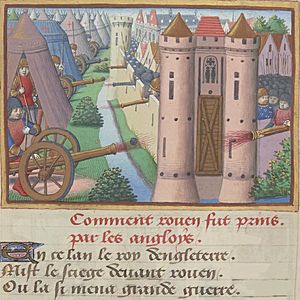Siege of Rouen (1418–1419) facts for kids
Quick facts for kids Siege of Rouen |
|||||||
|---|---|---|---|---|---|---|---|
| Part of The Hundred Years' War | |||||||
 The siege depicted in a late 15th-century miniature |
|||||||
|
|||||||
| Belligerents | |||||||
| Commanders and leaders | |||||||
| Guy Le Bouteiller Alain Blanchard |
|||||||
| Strength | |||||||
| 10,000 troops | 4,000 troops | ||||||
| Casualties and losses | |||||||
| Unknown troop casualties | Unknown troop casualties 12,000 civilian casualties |
||||||
The Siege of Rouen was a really important event during the Hundred Years' War. It happened from July 1418 to January 1419. During this time, English forces led by King Henry V captured the city of Rouen. Rouen was the capital of Normandy, a region in France. The English took it from the French defenders.
Why Rouen Was Important
At the time of the siege, Rouen was a very large city. About 20,000 people lived there. This made it one of the most important cities in all of France. Capturing Rouen was key for the English. It was a big step in their plan to take over Normandy. The French had made Rouen's defenses very strong. It was the toughest city the English had faced so far. The year before, King Henry V had also captured Caen, another important city in Normandy.
Getting Ready for the Siege
When the English army arrived at Rouen, the city walls were very well protected. There were 60 towers, and each tower had three cannons. The city also had 6 gates, each guarded by a special fortress called a barbican. The French had sent 4,000 extra soldiers to defend Rouen. Plus, about 16,000 regular citizens were ready to stay and help defend the city.
The city's defense was led by an army of crossbow men. Their commander was Alain Blanchard. He was second in command to Guy le Bouteiller. Guy le Bouteiller was a captain from Burgundy and the main leader of Rouen's defense.
The Siege Begins
King Henry V decided to completely surround Rouen. He set up four strong camps around the city. He also blocked the River Seine with heavy iron chains. This meant no supplies could get into the city. The English planned to starve the defenders out.
The duke of Burgundy, John the Fearless, had taken control of Paris. But he did not try to help Rouen. He told the citizens to take care of themselves.
By December, the people inside Rouen were running out of food. They had to eat cats, dogs, horses, and even mice. The streets were full of people who were starving. To save food, the city forced more than 12,000 poor people to leave. But King Henry would not let these people pass his army lines. So, these starving people were stuck. They had to live in the ditch that was dug around the city walls for protection. Even the English soldiers felt bad for them. On Christmas Day in 1418, King Henry allowed two priests to give food to these starving people. But this help was only for one day, and then the people went back to suffering.
The French soldiers inside the city tried to break out several times. But the English kept the siege going. On New Year's Eve, Guy le Bouteiller asked to talk with the English. After ten days of talks, the French defenders agreed to surrender. They said they would give up on January 19, 1419, if no help arrived. The French people who survived would get to keep their homes and things. In return, they had to give 80 hostages, pay a large sum of 300,000 gold crowns, and promise to be loyal to the English king. Alain Blanchard, who had executed English prisoners earlier, was executed by the English after the city fell.
What Happened Next
After taking Rouen, King Henry V continued his conquest of Normandy. He captured almost all of it. Only Mont-Saint-Michel managed to hold out against the English. Rouen became the main English base in northern France. This allowed King Henry to launch more attacks. He could now plan campaigns against Paris and other parts of France further south.

